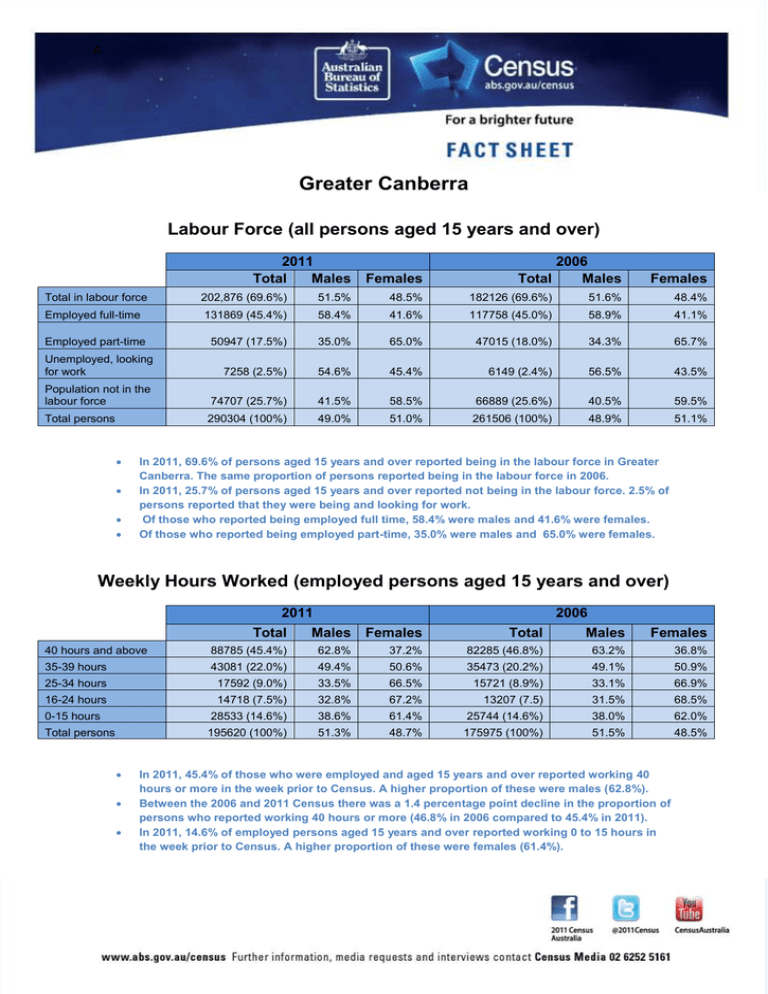Greater Canberra Labour Force (all persons aged 15 years and over) A
advertisement

A Greater Canberra Labour Force (all persons aged 15 years and over) 2011 Total Males Females Total 2006 Males Females Total in labour force 202,876 (69.6%) 51.5% 48.5% 182126 (69.6%) 51.6% 48.4% Employed full-time 131869 (45.4%) 58.4% 41.6% 117758 (45.0%) 58.9% 41.1% Employed part-time 50947 (17.5%) 35.0% 65.0% 47015 (18.0%) 34.3% 65.7% Unemployed, looking for work 7258 (2.5%) 54.6% 45.4% 6149 (2.4%) 56.5% 43.5% Population not in the labour force 74707 (25.7%) 41.5% 58.5% 66889 (25.6%) 40.5% 59.5% Total persons 290304 (100%) 49.0% 51.0% 261506 (100%) 48.9% 51.1% In 2011, 69.6% of persons aged 15 years and over reported being in the labour force in Greater Canberra. The same proportion of persons reported being in the labour force in 2006. In 2011, 25.7% of persons aged 15 years and over reported not being in the labour force. 2.5% of persons reported that they were being and looking for work. Of those who reported being employed full time, 58.4% were males and 41.6% were females. Of those who reported being employed part-time, 35.0% were males and 65.0% were females. Weekly Hours Worked (employed persons aged 15 years and over) 2011 Total Males Females 2006 Total Males Females 40 hours and above 88785 (45.4%) 62.8% 37.2% 82285 (46.8%) 63.2% 36.8% 35-39 hours 43081 (22.0%) 49.4% 50.6% 35473 (20.2%) 49.1% 50.9% 25-34 hours 17592 (9.0%) 33.5% 66.5% 15721 (8.9%) 33.1% 66.9% 16-24 hours 14718 (7.5%) 32.8% 67.2% 13207 (7.5) 31.5% 68.5% 0-15 hours 28533 (14.6%) 38.6% 61.4% 25744 (14.6%) 38.0% 62.0% Total persons 195620 (100%) 51.3% 48.7% 175975 (100%) 51.5% 48.5% In 2011, 45.4% of those who were employed and aged 15 years and over reported working 40 hours or more in the week prior to Census. A higher proportion of these were males (62.8%). Between the 2006 and 2011 Census there was a 1.4 percentage point decline in the proportion of persons who reported working 40 hours or more (46.8% in 2006 compared to 45.4% in 2011). In 2011, 14.6% of employed persons aged 15 years and over reported working 0 to 15 hours in the week prior to Census. A higher proportion of these were females (61.4%). A Greater Canberra Top five Industries in 2011 (employed persons aged 15 years and over) 2011 Total Males Public Administration and Safety Professional, Scientific and Technical Services Health Care and Social Assistance Education and Training Retail Trade Total persons Females 2006 Total Males Females 64048 (32.7%) 50.2% 49.8% 52994 (30.1%) 51.8% 48.2% 19121 (9.8%) 60.4% 39.6% 16721 (9.5%) 59.5% 40.5% 17935 (9.2%) 17125 (8.8%) 14820 (7.6%) 195620(100%) 23.3% 36.0% 47.1% 51.3% 76.7% 64.0% 52.9% 48.7% 15513 (8.8%) 15772 (9.0%) 15298 (8.7%) 175975 (100%) 22.1% 35.9% 46.3% 51.5% 77.9% 64.1% 53.7% 48.5% In 2011, the largest proportion of employed persons, aged 15 years and over, reported working in the Public Administration and Safety industry (32.7%). In 2006, the Public Administration and Safety Industry was the most reported response for employed persons aged 15 years and over (30.1%). The proportion of those who reported being employed in this industry increased by 2.6 percentage points in 2011. The proportion of employed persons aged over 15 who reported Retail Trade as their industry of employment has declined to 7.6% in 2011 compared to 8.7% in 2006. There has been a decline in the number of persons who reported being employed in this industry (478 persons). In 2011, males comprised 60.4% of the persons employed in Professional Scientific and Technical Services. In 2011, of persons employed in the industries of Health Care and Social Assistance and Education and Training, a higher proportion were females (76.7% and 64.0% respectively). A Greater Canberra Top five Occupations in 2011 (employed persons aged 15 years and over) 2011 Total Males Professionals Clerical and Administrative Workers Managers Technicians and Trades Workers Community and Personal Service Workers Total persons Females Total 2006 Males Females 57996 (29.6%) 49.5% 50.5% 51494 (29.3%) 50.3% 49.7% 37478 (19.2%) 31000 (15.8%) 30.6% 58.5% 69.4% 41.5% 33529 (19.1%) 27136 (15.4%) 29.7% 60.0% 70.3% 40.0% 19882 (10.2%) 83.3% 16.7% 18636 (10.6%) 82.4% 17.6% 18185 (9.3%) 195620 (100%) 39.3% 51.3% 60.7% 48.7% 15904 (9.0%) 175975 (100%) 38.8% 51.5% 61.2% 48.5% In 2011, 29.6% of employed persons aged 15 years and over reported working as professionals. 50.5% of these were females. Of persons who reported working as Clerical and Administrative Workers (19.2%), a higher proportion were females (69.4%). This compared to 10.2% of persons reporting as Technicians and Trades workers of whom 83.3% were males. A Greater Canberra Highest Level of Education (all persons aged 15 years and over) 2011 Total Males Postgraduate Degree Graduate Diploma and Certificate Females Total 2006 Males 17826 (6.8%) 60.3% 39.7% 25689 (8.8%) 57.1% 42.9% Females 11142 (3.8%) 39.9% 60.1% 9173 (3.5%) 40.8% 59.2% 61829 (21.3%) 46.0% 54.0% 51546 (19.7%) 47.2% 52.8% 26046 (9.0%) 44.1% 55.9% 22010 (8.4%) 43.3% 56.7% Certificate III/IV 31640 (10.9%) 67.4% 32.6% 26752 (10.2%) 70.5% 29.5% Year 12 56857 (19.6%) 49.4% 50.6% 53151 (20.3%) 49.0% 51.0% Year 11 or below (includes Certificate I/II/nfd) 51456 (17.7%) 41.6% 58.4% 53641 (20.5%) 40.4% 59.6% Total persons 290303 (100%) nfd not further defined 49.0% 51.0% 261505 (100%) 48.9% 51.1% Bachelor Degree Advanced Diploma and Diploma In 2011, there was a significant increase in persons who reported completing a Postgraduate Degree. This increased from 17,826 in 2006 to 25,689 in 2011 (a 44.1% increase). There has also been significant increase in numbers of those who reported completing a Graduate Diploma or Graduate Certificate as their highest level of education. This increased from 9,173 in 2006 to 11,142 in 2011 (an increase of 21.5%). There was a significant increase in the number of persons who reported completing a Bachelor Degree as their highest level of education, from 51,546 in 2006 to 61,829 in 2011 (an increase of 19.9%). There has been a decline in the number of persons who reported Year 11 and below (including Certificate level I/II), as their highest level of education, from 53,641 in 2006 to 51,456 in 2011. A higher proportion of females than males those reported their highest level of education as Graduate Diploma or Graduate Certificate, Bachelor Degree and Advanced Diploma or Diploma (60.1%, 54.0% and 55.9% respectively). Of those who reported completing Certificate III/IV as their highest level of education, a higher proportion were males (67.4%). A Greater Canberra Top five Fields of Study in 2011 (all persons aged 15 years and over who stated a completed qualification) Society and Culture Management and Commerce Engineering and Related Technologies Health Education Total persons Total 2011 Males Females Total 2006 Males Females 36308 (19.4%) 42.1% 57.9% 29595 (18.5%) 44.1% 55.9% 35480 (19.0%) 40.9% 59.1% 27968 (17.5%) 40.0% 60.0% 17963 (9.6%) 13597 (7.3%) 12825 (6.9%) 187170 (100%) 90.8% 22.5% 24.1% 50.4% 9.2% 77.5% 75.9% 49.6% 16326 (10.2%) 11341 (7.1%) 11572 (7.2%) 160242 (100%) 91.4% 21.1% 24.5% 51.0% 8.6% 78.9% 75.5% 49.0% In 2011 Society and Culture (19.4%) and Management and Commerce (19.0%) were the two most common fields of study completed that were reported by persons aged 15 years and over. These fields were also reported as the most common fields of study in the 2006 Census. Of those who reported Society and Culture as their field of study in 2011, a higher proportion were females (57.9%). Of those who reported Engineering and Related Technologies as their field of study, the proportion of males were significantly higher (90.8%). Almost three quarters of those who reported Health and Education as fields of study in 2011 were females (77.5% and 75.9% respectively). A Greater Canberra Top five Methods of travel to work in 2011 (employed persons aged 15 years and over) Car, as driver Car, as passenger Bus Walked only Bicycle Total persons 2011 Total Persons 2006 Total Persons 121,972 (62.4%) 13,607 (7.0%) 11,024 (5.6%) 8,136 (4.2%) 4,669 (2.4%) 195,620 (100%) 107,472 (61.1%) 12,987 (7.4%) 10,220 (5.8%) 7,377 (4.2%) 3,752 (2.1%) 175,975 (100%) Transport by car continues to be the most commonly reported method of travel to work. Almost two thirds (69.4%) of employed persons aged 15 years and over reported that they travelled to work by car (either as driver or a passenger) on 9 August 2011. The number of persons who walked to work has increased slightly from 7,377 in 2006 to 8,136 in 2011. The proportion of persons who walked to work between 2006 and 2011 has remained the same at 4.2%. A Greater Canberra Place of usual residence 1 year ago for Greater Canberra residents who moved in the year prior to 2011 (excluding persons aged under one year) 2011 2006 Within Territory 36,147 (59.3%) 31,938 (59.4%) Interstate 16,955 (27.8%) 15,857 (29.5%) Overseas 7,405 (12.1%) 5,559 (10.3%) Total persons 60,962 (100%) 53,741 (100%) Of the Greater Canberra residents who moved in the year prior to the 2011 Census, most moved from within the Territory (59.3%). There were 7,405 (12.1%) persons who either returned or migrated to Australia, from overseas, to settle in Greater Canberra, in the year prior to the 2011 Census. Place of usual residence 5 years ago for Greater Canberra residents who moved in the year prior to 2011 (excluding persons aged under five years) 2011 2006 Within Territory 72,272 (50.9%) 68,160 (54.2%) Interstate 45,495 (32.1%) 42,624 (33.9%) Overseas 22,874 (16.1%) 14,450 (11.9%) Total persons 141,879 (100%) 125,695 (100%) Of the Greater Canberra residents who moved in the five years prior to the 2011 Census, most moved from within the Territory (50.9%). There were 22,874 (16.1%) persons who either returned or migrated to Australia, from overseas, to settle in Greater Canberra, in the five years prior to the 2011 Census.





